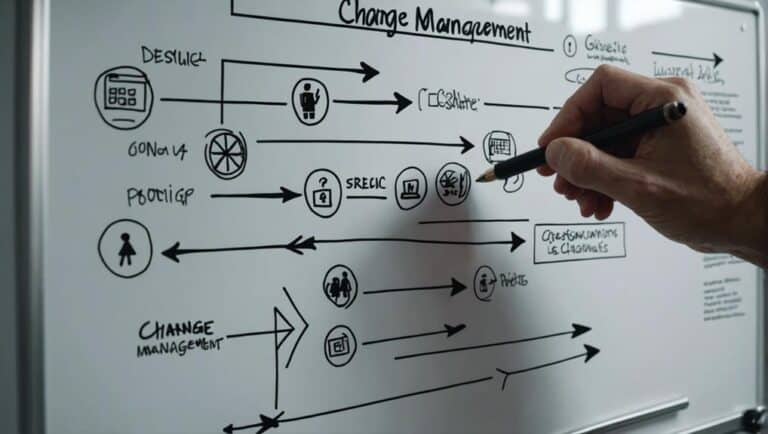A company could bring about its own downfall by not having a well-planned and implemented response to the continuously shifting market conditions. The people side of change is sometimes taken too lightly, and its actual value is realized too late.
Without proper change management, companies have to deal with costs and risks on a project level and the organization level as a whole. These consequences affect the employees’ productivity and morale. Project budgets and turnovers can be avoided by investing in continuous change management.
The rest of this article will look closer at the price companies pay when they fail to invest in change management.
The Consequences of Poor Change Management
There are many consequences a company will have to face if they don’t place enough value on change management—especially as it regards people.
These consequences often happen on a project level but can expand to the organization level. Let us examine each one of them.
Project Level
The first area to be affected by poor change management is projects that are in the pipeline. This can result in consequences that are detrimental to the organization and its stakeholders.
Costs
- Project delays. The lack of guidance that comes with poor change management will inevitably cause project delays. This can produce a ripple effect that will see the negative impacts spread to the organizational level.
- Budget overruns. The delays and necessary adjustments that come with a crisis could prove costly and exceed allocated budgets.
Risks
- Resistance. Without proper management guiding employees through a period of change, resistance can be the most expected reaction. Resistance means more time will be required for the adoption of changes and could also entail more training for the employees.
- The project is put on hold. As other costs and risks come into play, the impact could be so great that the project needs to be put on hold. This delay will, in turn, result in negative effects that will affect the entire company.
- Unavailability of resources. Project delays, budget overruns, and resistance from employees involved would certainly signal trouble to the higher-ups, who may be reluctant to invest further resources in a project that has so many issues. The withholding of these resources would only further doom the project.
- The project fails to deliver results. As the costs and risks pile on, it becomes impossible for the project to deliver results. Milestones are missed and desired outcomes are not realized.
- The project is fully abandoned. With all these factors playing against the project, the company may decide to cut its losses and entirely abandon the project. This failure would only pave the way for further issues that could extend to the organizational level.
Organization Level
Poor change management can be felt across the entire organization, and it may even have adverse impacts outside it.
Costs
- Productivity plunges. When the consequences of poor change management extend beyond the project level into the organizational level, the plunges in productivity become deeper and more sustained, lasting well beyond the end of the failed project and impacting future projects.
- Loss of valued employees. Some employees may not be able to take the fallout of a failed project stemming from poor change management. As a result, they may decide to leave the company and start over with employment elsewhere.
- Reduced quality of work. A reduction in the quality of work can be expected following the other organization-level costs.
Risks
- Impact on customers. The consequences of poor change management can ultimately be felt by the customers in the late delivery of goods and services and in their lowered quality.
- Impact on suppliers. Suppliers are not spared in these situations. The delays in projects would push back purchases of supplies for future projects.
- Decline in morale. Needless to say, the employees’ morale will take a battering from failures resulting from poor change management. The compounded project-level and organization-level consequences are sure to dampen spirits in the workplace.
- Legacy of failed change. Previous failures can have a lasting impact on employees and deeply affect their attitudes toward future changes. There may be a pessimistic sentiment among them that because the last attempt at a deviation from the status quo resulted in a massive failure, it will be the same each and every time.
- Stress, confusion, and fatigue. The massive costs on the organization level would take their toll on the employees’ mental and physical health.
- Change saturation. These failures can lead to employee frustration and change fatigue.
The costs and risks involved in poor change management often give rise to one another, creating a domino effect of sorts. What companies often fail to realize is that these can all be avoided. To their detriment, they continue to view change management as optional.
Why Change Management Can Be Challenging
In the corporate setting, as in life, change is often an unpleasant inconvenience. By nature, people are not wired to receive change with open arms. On the contrary, change is often met with resistance. This couldn’t be more true in the workplace.
The “people side of change,” as it is called, can be quite delicate. But as employees’ individual responses to change significantly impact day-to-day operations, change management must be carefully thought out and effectively implemented.
Employees are the backbone of the company, and they cannot adopt change proficiently if they are not equipped with the tools to get on board or if they do not understand why the change is happening in the first place.
Effective change management can prepare employees and guide them through periods of change as they depart from the status quo.
How Can AI Improve Change Management Processes?
AI can effectively streamline change management processes by analyzing data, predicting potential obstacles, and providing personalized recommendations. The benefits of AI and change management include increased efficiency, reduced resistance to change, and overall improved performance within organizations. The use of AI can also help in promoting a culture of continuous improvement and adaptation.
Final Thoughts
The costs that go into the people side of change are incomparable to the costs and risks a company would be confronted with if its employees are not prepared and equipped to move forward in the face of an ever-changing market.
It would not suffice either to have a half-baked change management plan. Successful companies are those that have realized how vital this factor is in continuously hitting their marks, and the investment they put into change management always proves to be worth it.
Sources





